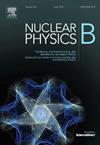Probing the high temperature symmetry breaking with gravitational waves from domain walls
IF 2.8
3区 物理与天体物理
Q2 PHYSICS, PARTICLES & FIELDS
引用次数: 0
Abstract
The symmetry can be broken at high temperature and then restored at low temperature, which is the so-called high temperature symmetry breaking. It often appears in some theories such as the high scale electroweak baryogenesis mechanism. In this paper, we probe the high temperature symmetry breaking with gravitational waves (GWs) from the melting domain walls. We first introduce a scalar with symmetry and a few singlet fermions that interact with scalar through a five-dimension operator. This leads to that the scalar potential has a non-zero minimum at high temperature. At the early stage, the scalar is pinned at symmetric phase due to the large Hubble fraction. When the scalar field's thermal mass becomes comparable to the Hubble parameter, it can quickly roll down to the minimum of potential. Then the symmetry is spontaneously broken and the domain walls will form. With the decrease of temperature, symmetry will be restored. We find that if domain walls are formed at , the GW produced by the melting domain walls is expected to be observed by BBO, CE and ET. In addition, we also discuss the relationships between this scenario and NANOGrav signal.
用畴壁引力波探测高温对称性破缺
这种对称性可以在高温下被打破,然后在低温下恢复,这就是所谓的高温对称性破缺。它经常出现在一些理论中,如高尺度电弱重子发生机制。本文用引力波(GWs)探测了熔化畴壁的高温Z2对称破缺。我们首先引入一个具有Z2对称性的标量和一些通过五维算子与标量相互作用的单重态费米子。这导致标量势在高温下有一个非零的最小值。在早期阶段,由于哈勃分数很大,标量被固定在对称相位。当标量场的热质量变得与哈勃参数相当时,它可以迅速滚动到最小势能。然后,Z2对称性被自发破坏,形成畴壁。随着温度的降低,Z2对称将恢复。我们发现,如果在O(109)GeV下形成畴壁,则熔畴壁产生的GW有望被BBO、CE和ET观测到。此外,我们还讨论了这种情况与nanogravity信号之间的关系。
本文章由计算机程序翻译,如有差异,请以英文原文为准。
求助全文
约1分钟内获得全文
求助全文
来源期刊

Nuclear Physics B
物理-物理:粒子与场物理
CiteScore
5.50
自引率
7.10%
发文量
302
审稿时长
1 months
期刊介绍:
Nuclear Physics B focuses on the domain of high energy physics, quantum field theory, statistical systems, and mathematical physics, and includes four main sections: high energy physics - phenomenology, high energy physics - theory, high energy physics - experiment, and quantum field theory, statistical systems, and mathematical physics. The emphasis is on original research papers (Frontiers Articles or Full Length Articles), but Review Articles are also welcome.
 求助内容:
求助内容: 应助结果提醒方式:
应助结果提醒方式:


